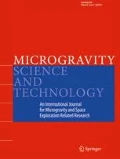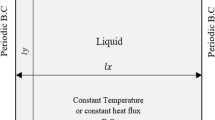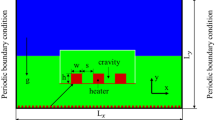Abstract
Under both normal gravity and microgravity conditions, pool boiling is an efficient mode of heat transfer which has been widely applied in practice. Studying the influence of gravitational acceleration on boiling heat transfer is not only of academic significance, but also helpful for the design of space equipment related to boiling. With the development of computer technology, numerical method has been a new reliable way to investigate the boiling heat transfer under different gravities. Pseudopotential lattice Boltzmann (i.e., LB) model is one of the most popular multiphase LB models, in which the phase interface could be formed, disappeared and migrated naturally. In this paper, the Multi-Relaxation-Time (i.e., MRT) pseudopotential LB model coupled with phase-change model was applied to simulate the pool boiling heat transfer under different gravitational accelerations and wall superheats. Pool boiling curves under different gravities were obtained. It’s found that: 1) the pool boiling heat transfer coefficient at a given wall superheat decreases with a decrease in gravity; 2) the wall superheat, as well as heat flux, at the CHF (i.e., critical heat flux) point and ONB (i.e., onset of the nucleate boiling) decrease gradually with a decrease in gravity. In addition, based on the numerical results, a new gravity scaling model was proposed to predict the influence of gravitational acceleration on the nucleate boiling heat transfer under different wall superheats. Finally, the new gravity scaling model was proved to be capable of predicting the heat flux during the nucleate boiling under different wall superheats and gravities.












Similar content being viewed by others
Abbreviations
- a,b,R,ω :
-
parameters in EOS
- T sat :
-
saturation temperature
- c v :
-
specific heat at constant volume
- T w :
-
temperature of the heated surface
- e α :
-
lattice velocity vector
- u :
-
fluid velocity
- f α, f :
-
distribution function for density
- v :
-
real fluid velocity
- F :
-
external force
- v 0 :
-
characteristic velocity
- F α’:
-
forcing term in the velocity space
- w α :
-
weighting coefficient
- F ads :
-
fluid-solid interaction force
- x :
-
position
- F g :
-
buoyancy force
- F m :
-
intermolecular interaction force
- g :
-
gravitational acceleration
- G :
-
interaction strength
- θ w :
-
contact angle
- G w :
-
a parameter to tune the contact angle
- ∆t :
-
time step
- h fg :
-
latent heat of vaporization
- ∆T :
-
wall superheat
- ρ :
-
density
- Ja :
-
Jacob number
- σ :
-
parameter to tune the mechanical stability
- l 0 :
-
characteristic length
- L x :
-
width of computational domain
- L y :
-
height of computational domain
- M :
-
orthogonal transformation matrix
- p :
-
pressure
- p c :
-
critical pressure
- p EOS :
-
prescribed non-ideal equation of state
- R b :
-
liquid radius
- s(x):
-
switch function
- S :
-
forcing term in the moment space
- τ :
-
relaxation time
- χ :
-
thermal diffusion coefficient
- ν :
-
kinematic coefficient of viscosity
- γ :
-
surface tension
- P :
-
pressure tensor
- Λ :
-
diagonal matrix of relaxation time
- Π :
-
viscous stress tensor
- κ :
-
parameter to tune the surface tension
- μ :
-
dynamic coefficient of viscosity
- λ :
-
thermal conductivity
- ψ :
-
pseudopotential
- Q loc(x, t):
-
local heat flux on the heated surface
- Q s(t):
-
space- averaged heat flux
- Q :
-
time- and space- averaged heat flux
- t :
-
time
- t 0 :
-
characteristic time
- T :
-
temperature
- T c :
-
critical temperature
- *:
-
dimensionless properties
- α :
-
lattice direction
- c :
-
critical properties
- L, V :
-
liquid, vapor
- x, y :
-
direction
- eq :
-
equilibrium properties
References
Aktinol, E., Dhir, V.K.: Numerical simulation of nucleate boiling phenomenon coupled with thermal response of the solid. Microgravity Sci Technol. 24, 255–265 (2012)
Dhruv, A., Balaras, E., Riaz, A., Kim, J.: A formulation for high-fidelity simulations of pool boiling in low gravity. Int. J. Multiphase Flow. 120, 103099 (2019)
Du, W., Zhao, J.: Gravity scaling law of heat transfer in nucleate pool boiling. Chin. Sci. Bull. (2019)
Gong, S., Cheng, P.: A lattice Boltzmann method for simulation of liquid–vapor phase-change heat transfer. Int. J. Heat Mass Transf. 55, 4923–4927 (2012)
Gong, S., Cheng, P.: Lattice Boltzmann simulation of periodic bubble nucleation, growth and departure from a heated surface in pool boiling. Int. J. Heat Mass Transf. 64, 122–132 (2013)
Gong, S., Cheng, P.: Lattice Boltzmann simulations for surface wettability effects in saturated pool boiling heat transfer. Int. J. Heat Mass Transf. 85, 635–646 (2015)
Gong, S., Cheng, P.: Direct numerical simulations of pool boiling curves including heater's thermal responses and the effect of vapor phase’s thermal conductivity. Int Commun Heat Mass Transfer. 87, 61–71 (2017)
Gunstensen, A.K., Rothman, D.H., Zaleski, S., Zanetti, G.: Lattice Boltzmann model of immiscible fluids. 43, 4320 (1991)
Guo, K., Li, H., Feng, Y., Zhao, J., Wang, T.: Numerical investigation on single bubble and multiple bubbles growth and heat transfer during flow boiling in a microchannel using the VOSET method. Microgravity Sci Technol. 31, 381–393 (2019)
Hazi, G., Markus, A.: On the bubble departure diameter and release frequency based on numerical simulation results. Int. J. Heat Mass Transf. 52, 1472–1480 (2009)
Incropera, F.P., Lavine, A.S., Bergman, T.L., DeWitt, D.P.: Fundamentals of Heat and Mass Transfer. Wiley (2007)
Kandlikar, S.G.: A theoretical model to predict Pool boiling CHF incorporating effects of contact angle and orientation. J. Heat Transf. 123, 1071–1079 (2001)
Kim, J., Benton, J.F., Wisniewski, M.: Transfer, Pool boiling heat transfer on small heaters: effect of gravity and subcooling. 45, 3919–3932 (2002)
Kupershtokh, A.L., Medvedev, D.A., Karpov, D.I.: On equations of state in a lattice Boltzmann method. Comput Math Appl. 58, 965–974 (2009)
Lee, R.C., Nydahl, J.E.: Numerical calculation of bubble growth in nucleate boiling from inception through departure. J. Heat Transf. 111, 474–479 (1989)
Lee, H.S., Herman, M., Jr Chiaramonte, H.: Transfer, Pool boiling curve in microgravity. 11, 216–222 (1997)
Li, Q., Luo, K.H.: Achieving tunable surface tension in the pseudopotential lattice Boltzmann modeling of multiphase flows. Phys. Rev. E Stat. Nonlinear Soft Matter Phys. 88, 053307 (2013)
Li, Q., Luo, K.H., Li, X.J.: Lattice Boltzmann modeling of multiphase flows at large density ratio with an improved pseudopotential model. Phys. Rev. E Stat. Nonlinear Soft Matter Phys. 87, 053301 (2013)
Li, Z.-D., Zhang, L., Zhao, J.-F., Li, H.-X., Li, K., Wu, K.: Numerical simulation of bubble dynamics and heat transfer with transient thermal response of solid wall during pool boiling of FC-72. Int. J. Heat Mass Transf. 84, 409–418 (2015a)
Li, Q., Kang, Q.J., Francois, M.M., He, Y.L., Luo, K.H.: Lattice Boltzmann modeling of boiling heat transfer: the boiling curve and the effects of wettability. Int. J. Heat Mass Transf. 85, 787–796 (2015b)
Li, Q., Huang, J.Y., Kang, Q.J.: On the temperature equation in a phase change pseudopotential lattice Boltzmann model. Int. J. Heat Mass Transf. 127, 1112–1113 (2018)
Ling, K., Li, Z.Y., Tao, W.Q.: A direct numerical simulation for nucleate boiling by the VOSET method, numerical heat transfer. Part A: Appl. 65, 949–971 (2014)
Ma, X., Cheng, P., Gong, S., Quan, X.: Mesoscale simulations of saturated pool boiling heat transfer under microgravity conditions. Int. J. Heat Mass Transf. 114, 453–457 (2017)
Mukherjee, A., Dhir, V.K.: Study of lateral merger of vapor bubbles during nucleate Pool boiling. J. Heat Transf. 126, 1023–1039 (2004)
Nejati, I., Sielaff, A., Franz, B., Zimmermann, M., Hänichen, P., Schweikert, K., Krempel, J., Stephan, P., Martin, A., Scheerer, H., Engler, T., Oechsner, M.: Experimental investigation of single bubble nucleate boiling in microgravity. Microgravity Sci Technol. 32, 597–607 (2020)
Pandey, V., Biswas, G., Dalal, A.: Saturated film boiling at various gravity levels under the influence of electrohydrodynamic forces. Phys. Fluids. 29, 032104 (2017)
Raj, R., Kim, J., McQuillen, J.: Subcooled Pool boiling in variable gravity environments. J. Heat Transf. 131, (2009)
Raj, R., Kim, J., McQuillen, J.: Gravity scaling parameter for Pool boiling heat transfer. J. Heat Transf. 132, 091502–091509 (2010)
Raj, R., Kim, J., McQuillen, J.: On the scaling of Pool boiling heat flux with gravity and heater size. J. Heat Transf. 134, (2011)
Raj, R., Kim, J., McQuillen, J.: Pool boiling heat transfer on the international Space Station: experimental results and model verification. J. Heat Transf. 134, 101504–101514 (2012)
Rajan, V.K., Chandramouli, V., Seshadri, S., Muniyandi, V.: Electrohydrodynamic effects on single bubble growth and departure under microgravity conditions: a numerical investigation. Microgravity Sci Technol. 31, 805–819 (2019)
Rohsenow, W.M.: A method of correlating heat-transfer data for surface boiling of liquids. Trans Asme. 74, (1951)
Rothman, D.H., Keller, J.M.: Immiscible cellular-automaton fluids. J. Stat. Phys. 52, 1119–1127 (1988)
Shan, X., Chen, H.: Lattice Boltzmann model for simulating flows with multiple phases and components. Phys Rev E Stat Phys Plasmas Fluids Relat Interdisc Topics. 47, 1815–1819 (1993)
Siegel, R., Keshock, E.G.: Effects of reduced gravity on nucleate boiling bubble dynamics in saturated water. AICHE J. 10, 509–517 (1964)
Son, G., Dhir, V.K.: Dynamics and heat transfer associated with a single bubble during nucleate boiling on a horizontal surface. J. Heat Transf. 121, 623–631 (1999)
Swift, M.R., Osborn, W.R., Yeomans, J.M.: Lattice Boltzmann simulation of nonideal fluids. Phys. Rev. Lett. 75, 830–833 (1995)
Wu, K., Li, Z.D., Zhao, J.F., Li, H.X., Li, K.: Partial nucleate Pool boiling at low heat flux: preliminary ground test for SOBER-SJ10. Microgravity Sci Technol. 28, 165–178 (2016)
Yi, T.-H., Lei, Z.-S., Zhao, J.-F.: Numerical investigation of bubble dynamics and heat transfer in subcooling pool boiling under low gravity. Int. J. Heat Mass Transf. 132, 1176–1186 (2019)
Zhang, L., Li, Z.-D., Li, K., Li, H.-X., Zhao, J.-F.: Influence of heater thermal capacity on bubble dynamics and heat transfer in nucleate pool boiling. Appl. Therm. Eng. 88, 118–126 (2015)
Zhao, J.F.: Two-phase flow and pool boiling heat transfer in microgravity. Adv Mech. 36, 135–143 (2010)
Zhao, J.F., Li, J., Yan, N., Wang, S.F.: Bubble behavior and heat transfer in quasi-steady pool boiling in microgravity. Microgravity Sci Technol. 21, 175–183 (2009)
Zuber, N.: Hydrodynamic Aspects of Boiling Heat Transfer, In, Vol. Ph.D. University of California, Los Angeles (1959)
Acknowledgements
This work was supported financially by the joint fund between the Chinese Academy of Sciences (CAS) and National Natural Science Foundation of China (NSFC) under the Grant of U1738105.
Author information
Authors and Affiliations
Corresponding authors
Additional information
Publisher’s Note
Springer Nature remains neutral with regard to jurisdictional claims in published maps and institutional affiliations.
Highlights
1) Simulations of pool boiling processes at different gravity levels were performed.
2) Wall superheat and heat flux at ONB decreased with a decrease in gravity.
3) Wall superheat at CHF point and CHF decreased with a decrease in gravity.
4) A new scaling model for the nucleate boiling heat transfer was proposed.
Appendix: the determination of surface tension and contact angle.
Appendix: the determination of surface tension and contact angle.
In the two-dimensional simulations, according to the Laplace equation of capillary, the relationship between the pressure difference across the interface of a droplet Δp and the radius of this droplet satisfies Eq. (A-1).
where γ is the surface tension. It can be seen from Eq. (A-1) that the pressure difference across the interface of the droplet is proportional to the inverse of droplet radius, and the proportionality coefficient equals to the surface tension.
To determine the surface tension in our simulations, the static droplets with different radii are simulated. In the simulations, a 120 × 120 computational domain is adopted and the periodic boundary condition is utilized at all of the boundaries. The static droplet is located at the center of the computational domain. All of the parameters in Peng-Robinson EOS, Eqs. (6), (10) and (19), and the physical parameters of fluid are chosen as those in Chapter 3. The fluid-solid interaction force and the buoyancy force are ignored. Figure 13 represents the influence of droplet radii on the pressure difference across the phase interface. As shown in Fig. 13, our numerical results could be fitted with a straight line that goes through the origin point with a slope of 0.0748. According to the Laplace equation of capillary, the surface tension could be determined as γ = 0.0748.
In order to determine the wettability of the heated surface in our simulations, the equilibrium shape of a droplet on the horizontal wall is simulated and the static contact angle is measured. In this simulation, a 300 × 100 computational domain is adopted. The periodic boundary condition is adopted at the left and right boundaries, while the non-slip boundary condition is utilized at the top and bottom boundaries. The parameters in P-R EOS, Eqs. (6), (10), (11) and (19) and the physical parameters of fluid are chosen as those in Chapter 3. The gravitational acceleration is set to be 0, so the buoyancy force is ignored. Initially, a droplet with a radius of Rb = 30 is located at (150, 20). The simulation is carried out for 10,000 time steps to ensure that the equilibrium state has been reached. As shown in Fig. 14, the static contact angle is measured to be 27.3°.
Rights and permissions
About this article
Cite this article
Feng, Y., Li, H., Zhao, J. et al. Lattice Boltzmann Study on Influence of Gravitational Acceleration on Pool Nucleate Boiling Heat Transfer. Microgravity Sci. Technol. 33, 21 (2021). https://doi.org/10.1007/s12217-020-09864-2
Received:
Accepted:
Published:
DOI: https://doi.org/10.1007/s12217-020-09864-2






